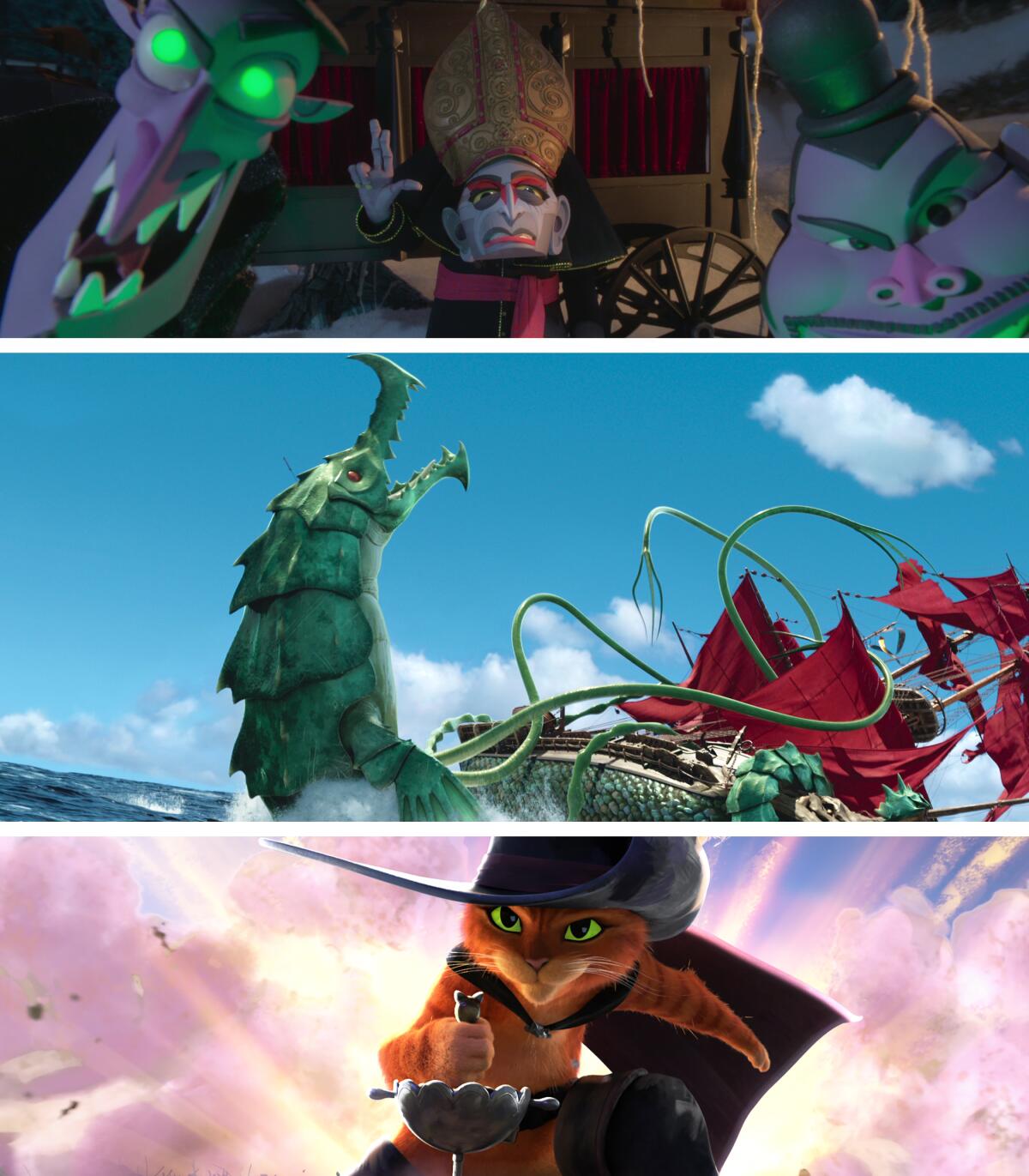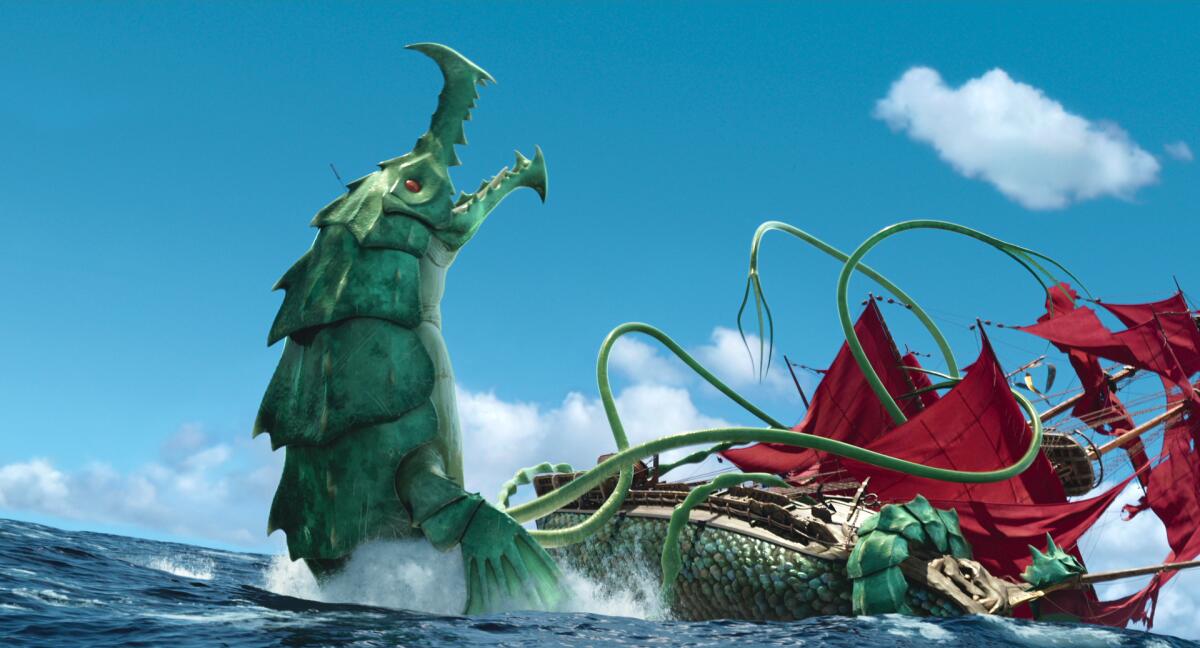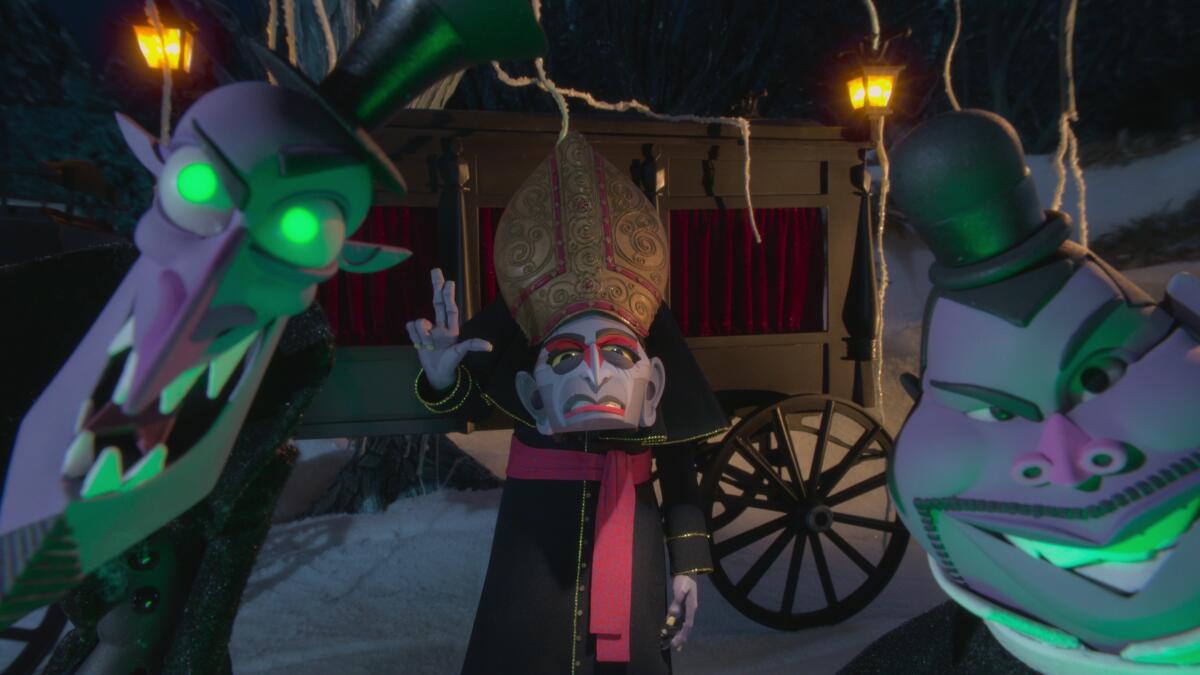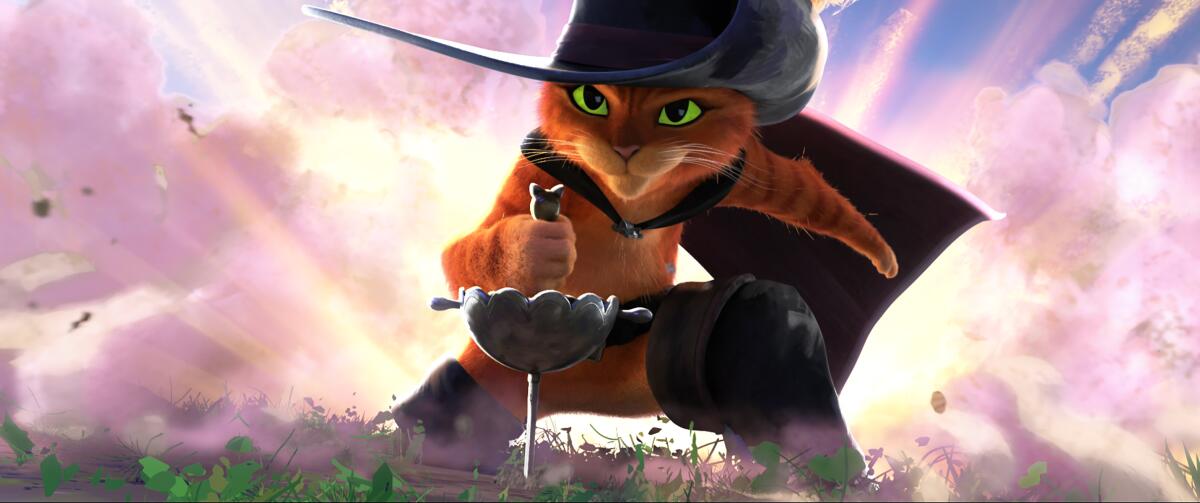How Jordan Peele, Antonio Banderas and sea monsters lift these animated films

- Share via
Among the contenders for the 2023 animated feature Oscar are a gorgeously framed, important lesson for kids (and adults); the return of Henry Selick in a collaboration with Jordan Peele; and a startlingly good entry in the “Puss in Boots”/“Shrek” franchise.

“The Sea Beast”
Chris Williams had always wanted to make the kind of “big action-adventure movie” he grew up loving — “King Kong,” “Raiders of the Lost Ark.” His gorgeously animated “The Sea Beast,” he says, is part “Master and Commander,” “Jaws” and “Treasure Island” mixed with kaiju (Japanese giant monster) cinema.
“I had this idea about sea-monster hunters that was inspired by those old unfinished maps they would populate with those really imaginative monsters,” says Williams. “I would just stare at those things. I thought, ‘Somebody’s got to make a movie that takes advantage of this kind of world and this sensibility.’”
In “The Sea Beast,” wooden ships do battle with sea monsters, keeping the seaside kingdom safe over generations of deadly combat. Those creatures are immaculately designed in the film, whether intended to frighten or make viewers want to cuddle them.
“We tried not to anthropomorphize the creatures too much,” Williams says of limiting the faces to animal expressions. “We wanted to make the acting more well-observed and true to animalistic behavior. ‘Black Stallion’ is a great example: We really get to know and love that horse, but obviously the horse is ... a horse.”
The filmmakers paid close attention to detail: the grain of the wood, the roughness of the cloth (“There were salt stains on the sailors’ pants,” Williams says), the layers of visibility in the water. The cinematography — the use of light and shadow, the movement of the camera — more resembles a live-action feature than standard animated fare.
“We would talk about our camera operators,” Williams says. “Is this a handheld shot? A crane shot? We looked at ‘Master and Commander’ and ‘Jaws.’ ”
What makes “The Sea Beast” stand out most, however, is the questions it encourages viewers to ask — including of themselves. What’s the root of these ancient hatreds? Are they inevitable? Who benefits?
“This cycle of violence perpetuates itself; it’s hard to break away from it. Sometimes there are powerful entities that will create narratives to perpetuate that. It’s important for everybody to really think about it and scrutinize everything you’re being told.”

“Wendell & Wild”
After his highly regarded “Coraline” (2009), stop-motion master Henry Selick entered a cinematic limbo. He joined Pixar and a number of projects arose, none coming to fruition. Then, during the run of “Key & Peele,” he remembered something that would rescue him.
“About 20 years ago, I’d done a sketch of my sons — they were little kids then, [and] they were acting particularly bad — as demons. I found it again and wrote a little seven-page story — maybe I’d get it published in the New Yorker or something,” Selick said. “It has almost all of the same characters as the feature — [demon brothers] Wendell and Wild escape the underworld to get rich in the land of the living by raising the dead.”
And here’s where his fandom of “Key & Peele” comes in.
“I was so inspired by the show, I thought Key and Peele would be perfect to play those demon brothers. I reached out to them; they were interested, very friendly, and Jordan wanted to meet face to face,” he says.
Peele wanted to do more than provide a voice. He had big dreams — he was starting a company, Monkey Paw Productions. He wanted to make an animated film he would have loved as a kid, with people who looked like him in it. To persuade the veteran filmmaker to let him in on the ground floor of what would become a Netflix production, he showed Selick a screenplay he was working on. It was called “Get Out.”
After reading that, the director said, “I felt like I’d be insane not to welcome him as an equal collaborator.”
Selick, of course, had much of “Wendell” in place — the themes of for-profit incarceration, the juvenile justice system and the school-to-prison pipeline; humans would be the villains despite the presence of the titular demons.
But co-writer Peele’s influence is felt throughout the film, starting with the ethnic diversity baked into it. Selick called that wide-open recasting of the characters something that “unlocked it — like a key to reimagining the whole film. Who are these characters? What’s the town they live in? What was a business that supported the town, who are the villains? I could go on and on, but that’s the beginning of the best collaboration I’ve ever had.”

“Puss in Boots: The Last Wish”
At the start of “Puss in Boots: The Last Wish,” the titular hero (voiced, as he must be, by Antonio Banderas) is “living a rock-star life,” says director Joel Crawford. He’s being feted as everyone (led by him) sings a song about what a singular hero he is — and an “incredibly humble” one, at that. But soon he learns he has burned through eight of his nine lives, forcing a reassessment of how he lives and who he is.
You know, as humans do from time to time.
Crawford says, “Antonio was very excited to go, ‘Let’s show the world what’s underneath the mask. Let’s expose his vulnerabilities.’ You get to see the struggle to do the right thing. It means more and he truly does become a hero we all can relate to.”
The result is a more sincere-feeling investigation of a protagonist’s mortality than one might expect in a studio animated feature for kids.
Visually, the filmmakers aimed for the look of a fairy-tale painting. There’s plenty of humor — it’s one of the funnier entries in the franchise — largely due to a new, nameless canine voiced by Harvey Guillén of “What We Do in the Shadows.” And the makers had fun thinly veiling references and inspirations throughout — spaghetti westerns, Clint Eastwood, Akira Kurosawa.
“We had so much fun pulling from that. Even the dog with no name is a reference to the Clint Eastwood Man With No Name. In ‘Seven Samurai,’ Toshiro Mifune plays that rogue samurai who becomes the heart of the team. He was one of our inspirations for the dog’s character,” Crawford says.
“I hope the audience really embraces and enjoys it.”
More to Read
From the Oscars to the Emmys.
Get the Envelope newsletter for exclusive awards season coverage, behind-the-scenes stories from the Envelope podcast and columnist Glenn Whipp’s must-read analysis.
You may occasionally receive promotional content from the Los Angeles Times.







